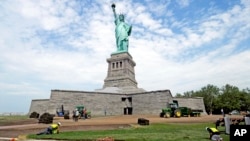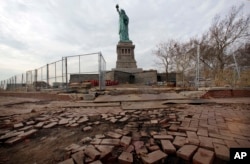NEW YORK —
The Statue of Liberty will reopen to visitors with a July 4 ceremony on Thursday, more than eight months after its home island in New York Harbor was flooded and wrecked by Superstorm Sandy.
Lady Liberty was protectively closed by the National Park Service last October as the historic storm approached.
Before the shutdown in October, the statue had been open for only a day following a year-long renovation.
The statue itself was left largely unscathed by the historic storm, but floodwaters left docks, buildings, walkways and electrical systems badly damaged or even destroyed on Liberty Island between lower Manhattan and New Jersey. About 75 percent of the island was covered by the storm surge.
Also damaged was nearby Ellis Island, where there is a museum in what was once the United States' principal immigration office. Officials said 100 percent of Ellis Island was covered by water during Sandy.
Both islands have been off-limits to the public since the storm.
While it was closed there was a disagreement over security arrangements for visitors to Lady Liberty, one of the nation's most famous landmarks.
The New York Police Department wanted screening to remain at the Battery Park ferry dock, where boats depart for the islands and where it has been in place since shortly after the attacks of September 11, 2001. The National Park Service, however, proposed moving the airport-style security screening of all visitors to Ellis Island, and then ferrying statue visitors on to Liberty Island.
In the end, the police department argument that the Park Service's proposal would make the ferries themselves more vulnerable to an attack prevailed.
U.S. Secretary of the Interior Sally Jewell and New York City Mayor Michael Bloomberg will attend the Independence Day opening ceremony on the island.
Ellis Island, which suffered greater damage, will remain closed indefinitely as repair work continues, a spokeswoman said on Wednesday.
The cost of damage to both islands was estimated earlier this year to be $59 million.
About 3.5 million people visit Liberty Island in a typical year, according to the National Park Service. The copper-clad statue, a gift from France to the United States, was dedicated in 1886 and declared a national monument in 1924.
Lady Liberty was protectively closed by the National Park Service last October as the historic storm approached.
Before the shutdown in October, the statue had been open for only a day following a year-long renovation.
The statue itself was left largely unscathed by the historic storm, but floodwaters left docks, buildings, walkways and electrical systems badly damaged or even destroyed on Liberty Island between lower Manhattan and New Jersey. About 75 percent of the island was covered by the storm surge.
Also damaged was nearby Ellis Island, where there is a museum in what was once the United States' principal immigration office. Officials said 100 percent of Ellis Island was covered by water during Sandy.
Both islands have been off-limits to the public since the storm.
While it was closed there was a disagreement over security arrangements for visitors to Lady Liberty, one of the nation's most famous landmarks.
The New York Police Department wanted screening to remain at the Battery Park ferry dock, where boats depart for the islands and where it has been in place since shortly after the attacks of September 11, 2001. The National Park Service, however, proposed moving the airport-style security screening of all visitors to Ellis Island, and then ferrying statue visitors on to Liberty Island.
In the end, the police department argument that the Park Service's proposal would make the ferries themselves more vulnerable to an attack prevailed.
U.S. Secretary of the Interior Sally Jewell and New York City Mayor Michael Bloomberg will attend the Independence Day opening ceremony on the island.
Ellis Island, which suffered greater damage, will remain closed indefinitely as repair work continues, a spokeswoman said on Wednesday.
The cost of damage to both islands was estimated earlier this year to be $59 million.
About 3.5 million people visit Liberty Island in a typical year, according to the National Park Service. The copper-clad statue, a gift from France to the United States, was dedicated in 1886 and declared a national monument in 1924.







